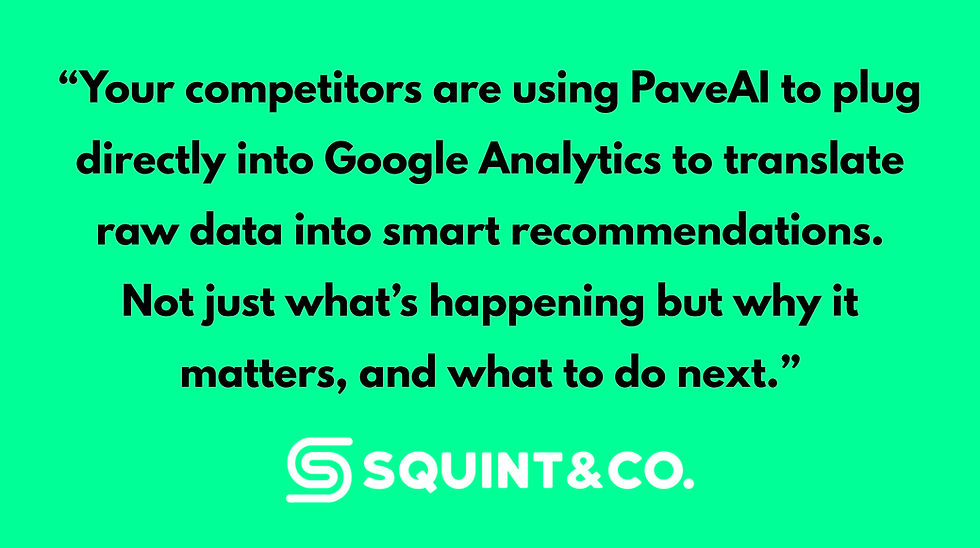What Competitors Using AI Know About Your Customers That You Don’t (Yet)
- Squint & Co

- May 27
- 4 min read
You know your customers right? You’ve got personas. Demographics. Maybe even a customer journey map from two rebrands ago.
But here’s the thing: while you’re trusting what you think you know, your competitors are using AI to uncover what your audience is actually doing, asking, clicking, avoiding, buying, and thinking - right now.
And that’s a problem.
Because AI doesn’t just give you data. It finds the patterns you’d never spot. It surfaces insights in real time. It updates constantly, while your spreadsheets gather dust.
So let’s pull back the curtain. Here’s what your AI-using competitors already know about your customers and how you can catch up (and overtake) fast.

🔍 1. They Know What Your Customers Are Actually Searching For
While you’re marketing staff are writing content around broad, obvious keywords (“digital marketing tips”) on ChatGPT, your competitors are zeroing in on search phrases your customers are typing into Google this week.
With Google Trends, they’re spotting spikes. With AI tools like Frase, they’re seeing what questions are being asked in forums, Reddit threads, and People Also Ask boxes. And with Signal AI, they’re tracking emerging language shifts - the new buzzwords, objections, and trending terms customers are using before they show up in a headline.
👉 What you can do:
Use Google Trends to monitor seasonal or unexpected spikes in searches
Plug your topic into Frase and grab the real-world questions people are asking
Watch how industry language is shifting, and mirror that tone in your content
🎯 Result: You don’t just “do SEO”, you align your voice with the exact problems, phrasing, and curiosity your customers are living with right now.
🖱️ 2. They Know Exactly Where Customers Drop Off
Your landing page looks great. But that doesn’t mean it’s working.
Competitors using Hotjar AI and Microsoft Clarity are watching how customers actually behave. Where they scroll. Where they pause. Where they click... and where they rage-quit.
They’re seeing what elements drive conversions and which ones quietly sabotage them.
Hotjar’s AI summaries do more than show a heatmap - they explain what’s going wrong. “Users are missing the CTA due to visual clutter.” “Most users never reach your offer section.” This kind of insight doesn’t just tweak design, it transforms performance.
👉 What you can do:
Install Hotjar and Clarity on your key pages
Use the AI-generated summaries to identify friction points
A/B test based on actual behaviour, not guesswork
🎯 Result: You fix what’s broken, fast. No more overhauls based on opinions. Just real, observable truth.
📊 3. They Know Which Metrics Actually Matter (And Which Are Vanity)
If your reporting still looks like an Excel graveyard full of bounce rates, pageviews, and click-through rates, you’re not alone.
But your competitors? They’re using PaveAI to plug directly into Google Analytics and translate raw data into smart recommendations. Not just what’s happening - why it matters, and what to do next.
Using Looker Studio (with AI-powered visualisation tools), they’ve built dashboards that track only the metrics that tie to outcomes: revenue, leads, retention, ROI.
👉 What you can do:
Connect Google Analytics to PaveAI and export the summary
Identify which pages drive action, not just traffic
Build a custom dashboard to monitor strategic KPIs
🎯 Result: You stop wasting time tracking everything and start measuring what matters.

📡 4. Competitors Using AI Know What the Market Is Thinking Before You Do
Competitors who’ve embraced AI aren’t just reacting to the market, they’re predicting it.
They’re using Signal AI to monitor press mentions, sentiment trends, competitor moves, and product announcements in real time. They know what topics are heating up. What language is shifting. What their customers will care about next month, not just last week.
Combine that with Crayon, and they’re watching every move you make: pricing changes, messaging tweaks, and campaign launches. If you blink, they’ll see it.
👉 What you can do:
Set up Signal AI to monitor your category, not just your brand
Track industry sentiment, not just volume
Use that intelligence to shape campaigns before the trend peaks
🎯 Result: You get ahead of the curve, instead of reacting to it.
🔄 5. They Iterate 10x Faster Than You Can
When your team is busy rewriting the same email for the sixth time, your competitors are scaling.
They’re using Zapier AI to automate data capture, follow-ups, and reporting. They’re using Notion AI to create brief templates, idea banks, and strategy docs that evolve in real time. And they’re using Frase to build content workflows that take a brief to first draft in minutes.
Their creative output doesn’t stop, it compounds.
👉 What you can do:
Use Notion AI to streamline planning, brainstorming, and SOPs
Build a Zapier workflow that connects your CMS, analytics, and email tools
Turn every campaign into a repeatable system
🎯 Result: Your team creates more, reacts faster, and scales campaigns that used to feel impossible.
🧠 The Takeaway: AI Isn’t Magic - It’s Market Awareness on Overdrive
Let’s be clear: using AI won’t automatically make you smarter. But if your competitors are feeding their AI tools the right questions, watching the right signals, and acting faster than you, they’re going to know your customer better than you do.
And they’ll win.
This isn’t about tools. It’s about what you do with them:
Turn questions into content
Turn heatmaps into action
Turn data into strategy
Turn insight into timing
Turn process into scale
You don’t need a crystal ball. You just need the right AI stack and the confidence to act on what it tells you.
Ready to Catch Up? Or Get Ahead?
At Squint & Co, we use the tools above daily. Not as gimmicks. As foundations.
Whether we’re running your marketing or helping your internal team build their own AI-powered systems, we’ll help you turn insight into impact.
.png)











